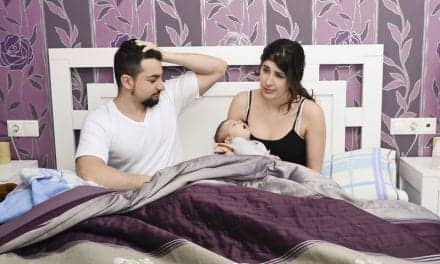Like more than 20 million other Americans, John Brugger has been diagnosed with sleep apnea. He snored, tossed and turned, and struggled to breathe during the night, which often left him not only exhausted the next day but also raised his risk of heart attack, stroke, and car accidents. Fed up, Brugger went to his doctor, who suggested he use a CPAP machine.
Brugger tried it a few times, but like more than half of those who get CPAP machines, he simply stopped using it. “I didn’t like it, honestly,” says Brugger, a father of five from Commerce City, Colo, in a release. “It was bulky and I had a hard time getting to sleep with it on my face.”
But after watching a dramatic and disturbing video of himself trying to sleep without his CPAP mask, Brugger has had a change of heart. “Now I can’t go to sleep without it. I won’t even take a nap without it,” he says.
The video was part of a pilot study led by Mark Aloia, PhD, a sleep expert at National Jewish Health in Denver. In it, Brugger watched himself writhe and periodically gasp for air during the night. “It was a powerful moment in my life,” Brugger says. “It made me cry watching it, and to see myself basically drowning in my sleep, made me very determined to fix that.”
That was Aloia’s objective from the outset. “Sleep apnea is one of those disorders you never really notice in yourself,” said Aloia. “I mean, you’re asleep, you’re consciously not aware of what’s happening to you,” he says.
Left untreated, sleep apnea has been linked to serious medical conditions including depression, diabetes, heart disease, and even cancer. It also raises the risk that a tired sleep apnea patient will fall asleep at the wheel and have a car accident.
“We somehow had to find a way to convince these patients of the urgency of their condition,” Aloia says.
At first, researchers showed patients videos of other people who struggled to breathe while sleeping without their masks. “Their reaction was ‘Wow, that’s really bad,’ and then probably internally some of them would say, ‘But I’m not like that,'” Aloia says. “Then we thought, why don’t we show people video from their own sleep study and see what the effect is?”
Turns out, the effect was dramatic. “We saw an increase in the use of CPAP of more than two hours a night, and after three months of follow-ups, the patients were still using them,” says Aloia. “We really created a personal sense of urgency in these patients in order to change their behavior.”
The pilot study worked so well that Aloia and his team at National Jewish Health have received a grant from the National Institutes of Health to expand the study. In the coming months, Aloia will test the approach on 300 patients and will follow their progress for an entire year.
“We were thrilled by the response,” Aloia says. “The shocking part was that patients actually got very emotional. Sometimes we’d have men, who had never really thought of themselves having a problem, being tearful.”
John Brugger was one of them. “I’ve been wearing my CPAP since the day I saw that video,” he says. “It changed my life. I wish I’d done it 20 years ago.”



